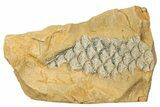This Specimen has been sold.
2.2" Carboniferous Scale Tree (Lepidodendron) Fossil - Utah
This is a beautifully preserved, 2.2" scale tree (lepidodendron) bark fossil from the Manning Canyon Shale located south of Salt Lake City, Utah. The fossil truly resembles fish scales, and has preserved the bark's texture incredibly well.
It comes with an acrylic display stand.
The Manning Canyon Shale is found in central Utah, near Provo. It hosts a number of Carboniferous-era plants, mostly from the Pennsylvanian-Mississippian ages. Over fifty species of plants have been identified out of the site.
It comes with an acrylic display stand.
The Manning Canyon Shale is found in central Utah, near Provo. It hosts a number of Carboniferous-era plants, mostly from the Pennsylvanian-Mississippian ages. Over fifty species of plants have been identified out of the site.
Lepidodendron, also known as scale trees, were primitive vascular plants, thriving in the swampy environments of the Carboniferous Period about 350 to 300 million years ago. Their closest modern relatives are club mosses. They reached heights comparable to modern trees, sometimes as high as 50 meters, or roughly 160 feet.
However, unlike most modern trees their growth habit was dichotomous: younger plants grew as a single stem, from which leaves protruded directly from the trunk. As they aged, the growing ends would split into new branches, eventually creating a fractal pattern similar to modern dragon trees.
Lepidodendron grew needle-like leaves from scale-like bases along stems, from which the plants are named. At the ends of branches were oval-shaped cones similar in shape to modern cones of a spruce or fir. These cones bore spores, and only grew from the crown.
Lepidodendron may have also been among the first plants to form mycorrhizal relationships with fungi, as fossil evidence between Lepidodendron "roots" (identical to stem tissues) and early fungal organisms has been found.
However, unlike most modern trees their growth habit was dichotomous: younger plants grew as a single stem, from which leaves protruded directly from the trunk. As they aged, the growing ends would split into new branches, eventually creating a fractal pattern similar to modern dragon trees.
Lepidodendron grew needle-like leaves from scale-like bases along stems, from which the plants are named. At the ends of branches were oval-shaped cones similar in shape to modern cones of a spruce or fir. These cones bore spores, and only grew from the crown.
Lepidodendron may have also been among the first plants to form mycorrhizal relationships with fungi, as fossil evidence between Lepidodendron "roots" (identical to stem tissues) and early fungal organisms has been found.
SPECIES
Lepidodendron sp.
LOCATION
Utah
FORMATION
Manning Canyon Shale
SIZE
Fossil: 2.2" wide, Shale: 3.1 x 1.95"
CATEGORY
ITEM
#256830
We guarantee the authenticity of all of our specimens.
 Reviews
Reviews












